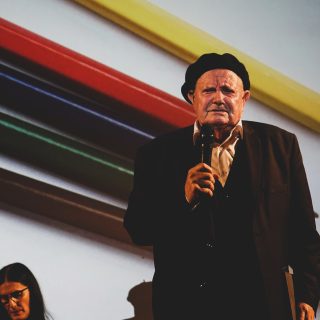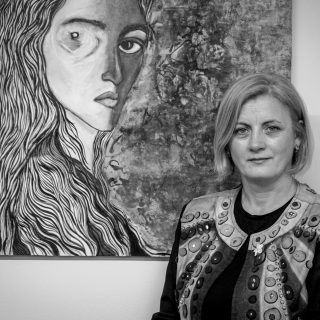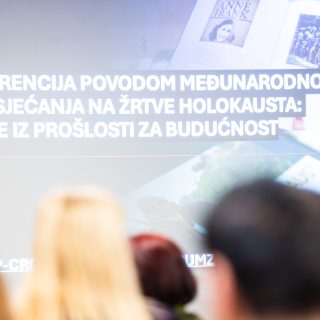An interview with Joanna Hanson and Shkelzen Gashi:
After the presentation of the NGO New Perspektiva project “Multi-perspective History Teaching in Kosovo” in August 2017, we asked Joanna and Shkelzen some questions, as we wanted to know more about their research and the findings.
B.P: Joanna and Shkelzen, in your project you have analysed how various events in Kosovo-Serbian history are presented very differently in the textbooks of both countries. Then you have also compared those two different narratives to the views of other international historians. What were your most important findings?
Joanna: As a basis for our discussions, we looked at different events in Kosovo’s history. We found that the single-perspective approach is present in the textbooks of both Kosovo and Serbia. This approach is exacerbated by unsubstantiated historical facts or language which is anachronistic and incorrect. Teachers told us they did not always agree with the textbooks but that politicians blocked their ability to change or modify the manner of teaching. These basic flaws need to be addressed in a committed manner.
Shkelzen: Many clear differences are revealed in the approach of the school history books in Serbia and in Kosovo towards the events in the territory of Kosovo. These differences can be grouped as follows: aspiration for ownership of the territory of Kosovo; presentation only of the crimes committed by the other side, presenting oneself as the victim and the other as the aggressor and silence on Albanian-Serbian collaboration. This shows that the countries are not sowing the seeds of reconciliation in the next generation.
B.P: Shkelzen, you have invested a lot of time into the data collection. Can you give us an example of the main narrative one can find in these textbooks?
Shkelzen: The most important elements of Kosovo’s history are the crimes committed by the Serbs, organised into regular army and police, against Albanians; as well as the crimes of the Albanians, mainly not organised, against the Serbs.
The Kosovar textbooks present only the crimes of the Serbs against Albanians in 1912, 1918-1919, and during the period between the two world wars, in 1945 and after the Second World War, as well as during the 1998-1999 war. It is rare that these textbooks offer information to quantify the Serbian crimes, and even when it is offered, it is in an exaggerated form.
The Serbian textbooks present only the crimes of the Albanians against the Serbs in 1915, 1941-1943, 1999-2000, describing them as ‘the attacks of local gangs of Albanians’ or ‘Albanian terror against Serbs’. These textbooks generally do not give data for these crimes.
B.P: Your website http://www.new-perspektiva.com/multiperspektiva promotes a multi-perspective approach to history. Can you tell us what you mean by that?
Joanna: There is no clear definition of a multi-perspective approach but we think this is a good one: It is “a strategy of understanding”, in which we take into account another’s perspective or others’ perspectives in addition to only a single one. It means being able and willing to regard and understand a situation from different perspectives.
B.P: Joanna, you refer to your multi-perspective approach as methodology. To what extent is it more than just a collection of secondary literature?
Joanna: The multi-perspective methodology of teaching and writing history is a complex discourse. Textbooks should contain a range of illustrations and examples of other sources e.g. documents, oral history, newspaper articles, to make them more readable and instructive to the students.
The multi-perspective methodology of teaching includes a whole range of teaching skills apart from the textbooks. It removes the practice of teaching history as a subject only to be memorised, because that does not enable the pupil to challenge the information or to interpret the facts and find different sources. Memorising is not conducive to students developing their critical thinking abilities. Teachers and textbooks, therefore, have to present their students with different sources and perspectives related to the history they are teaching. If teachers are teaching, e.g., what happened when Christopher Columbus arrived in the West Indies, they should ask their students to not only understand how and why he went there, but how members of his crew may have seen the journey, what it meant to the indigenous people on the islands. This can be done using textbooks but also other materials from illustrations and online documents or a visit to a museum.
It can be a difficult task for teachers and they need to have a clear concept of why they are teaching history. Teachers in Kosovo are now starting to have the opportunity to learn about using the multi-perspective approach so there is hope that teaching will become more open and including various perspectives. They need dedicated training to help them develop these skills.
B.P: Shkelzen, you mentioned the “silence on Albanian-Serbian collaboration” earlier as a characteristic of dealing with history in textbooks. What do you mean by that? Could you give us some examples of these collaborations?
Shkelzen: In none of the textbooks from Kosovo and Serbia is there mention of the meetings, agreements and collaboration of the political and military representatives of the Albanians with their Serb counterparts. There is e.g. no mention anywhere of:
– collaboration between some of the most significant leaders of the Albanian uprising (1912) with the Serbian representatives in Prishtina, from whom they got weapons to fight the Ottoman Empire;
– the meeting of the leader of the Albanian Kaçak movement remaining under Yugoslavia (after the First World War) with the local Serb authorities about living un-harassed, on condition that his movement extended to only three villages; and later another meeting with senior Serb officials where he asked for Kosovo to have the right for self-government;
– collaboration between the Legal Society for the Defence of Islam (after the First World War), which represented the Albanians in the Serbian parliament, and the two major Serbian political parties in Yugoslavia to the extent that sometimes these political parties even shared the same electoral list;
– close collaboration between the Albanian communists of Kosovo (during and following the Second World War) with the Serbian/ Yugoslav communists;
– the agreement of the leaders of peaceful resistance among the Albanians of Kosovo (1996) with the Serbian president to open up school and university buildings to Albanians in Kosovo; and later also the meetings between them on finding a peaceful solution for the Kosovo issue (1998).
So, I hope the future schoolbooks in Kosovo and Serbia will mention these meetings, agreements and collaboration of the political and military representatives of the Albanians with their Serb counterparts.
B.P: Historians aren’t usually very fond of making predictions, but maybe you could make an exception: Will future textbooks in Kosovo and Serbia contain more perspectives on events on Kosovo-Serbian history than the current ones?
Joanna: We are concerned with the historical single perspective-narrative in Kosovo and Serbia which does not enable students to interpret or question it. Nevertheless, there are increasing pressures, both domestic and international, on the education system to change this approach.
At our meetings with different groups of teachers, it became clear that there is a readiness of participants to discuss the issue of the multi-perspective approach to the teaching of history. Teachers see the impact of the dangers of the single-perspective approach, but they feel their role is restricted by politicians.
Euroclio training for teachers and changes to the curriculum are being introduced by the Ministry of Education. These include multi-perspective teaching for grades 6 and 7. I am, therefore, optimistic, as these are history-teaching processes which all European countries have undergone since the 1970s. I also believe the social media which provides a whole array of other historical sources, both good and bad, creates a pressure for change as well.
B.P: During your project you also organized discussions with a member of the Polish-German Textbook Commission, which were met with big interest – what do you think, is it maybe even realistic to think of having a joint Kosovo-Serbia textbook one day too?
Joanna: It would be excellent to have a joint Kosovo-Serbian textbook in the future, rather as there are joint Polish-German textbooks but this will take time. At present, however, both sides should focus on giving their pupils and students unbiased and widely-sourced multi-perspective narratives and access to sources of the other witnesses and participants in their joint history.
Thank you both very much for the insight in your project!
Joanna Hanson is a historian and the executive director of the Kosovo NGO New Perspektiva.
SHKELZEN GASHI works as an independent researcher for different NGOs. He completed his MA on Democracy and Human Rights on the joint study program of the Universities of Bologna and Sarajevo. He continually monitors the presentation of the history of Kosovo in the history schoolbooks in Kosovo, Albania, Serbia, Montenegro and Macedonia, and published the results of this research in 2016 in three languages. Shkelzen has spent time at the Georg Eckert Institute at Braunschweig, Germany researching and learning the skills of dealing with history in post conflict situations.



